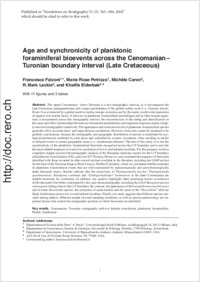Age and synchronicity of planktonic foraminiferal bioevents across the Cenomanian – Turonian boundary interval (Late Cretaceous)
- Falzoni, Francesca Dipartimento di Scienze della Terra ?A. Desio?, Università degli Studi di Milano, Italy.
- Petrizzo, Maria Rose Dipartimento di Scienze della Terra ?A. Desio?, Università degli Studi di Milano, Italy.
- Caron, Michèle Département de Geosciences, Institut de Géologie, Université de Fribourg, Switzerland.
- Leckie, R. Mark Department of Geosciences, University of Massachusetts-Amherst, USA.
- Elderbak, Khalifa Department of Geosciences, University of Massachusetts-Amherst, USA. - ALS Oil & Gas, Houston, USA
-
01.06.2018
Published in:
- Newsletters on Stratigraphy. - 2018, vol. 51, no. 3, p. 343–380
English
The upper Cenomanian – lower Turonian is a key-stratigraphic interval, as it encompasses the Late Cretaceous supergreenhouse and a major perturbation of the global carbon cycle (i. e., Oceanic Anoxic Event 2) as evidenced by a global positive carbon isotope excursion and by the nearly world-wide deposition of organic-rich marine facies. A turnover in planktonic foraminiferal assemblages and in other marine organisms is documented across this stratigraphic interval, but reconstruction of the timing and identification of the cause and effect relationships between environmental perturbations and organism response require a highly-resolved stratigraphic framework. The appearance and extinction levels of planktonic foraminiferal species generally allow accurate intra- and supra-basinal correlations. However, bioevents cannot be assumed to be globally synchronous, because the stratigraphic and geographic distribution of species is modulated by ecological preferences exhibited by each taxon and controlled by oceanic circulation, often resulting in earlier or delayed events in certain geographic areas (i. e., diachronous datums). The aim of this study is to test the synchronicity of the planktonic foraminiferal bioevents recognized across the C/T boundary and to provide the most reliable sequence of events for correlation of low to mid-latitude localities. For this purpose, we have compiled a highly-resolved biostratigraphic analysis of the European reference section for the C/T boundary at Eastbourne, Gun Gardens (UK), and core S57 (Tarfaya, Morocco), and correlated the sequence of bioevents identified with those recorded in other coeval sections available in the literature, including the GSSP section for the base of the Turonian Stage at Rock Canyon, Pueblo (Colorado), where we calculated reliable estimates of planktonic foraminiferal events that are well-constrained by radioisotopically and astrochronologically dated bentonite layers. Results indicate that the extinctions of Thalmanninella deeckei, Thalmanninella greenhornensis, Rotalipora cushmani and "Globigerinelloides" bentonensis in the latest Cenomanian are reliable bioevents for correlation. In addition, our analysis highlights other promising lowest occurrences (LOs) that need to be better constrained by bio- and chemostratigraphy, including the LO of Marginotruncana schneegansi falling close to the C/T boundary. By contrast, the appearance of Helvetoglobotruncana helvetica and of some Dicarinella species, the extinction of anaticinellids and the onset of the "Heterohelix" shift are likely diachronous across low to mid-latitude localities. Finally, our study suggests that different species concepts among authors, different sample size and sampling resolution, as well as species paleoecology are important factors that control the stratigraphic position at which bioevents are identified.
- Faculty
- Faculté des sciences et de médecine
- Department
- Département de Géosciences
- Language
-
- English
- Classification
- Geology
- License
-
License undefined
- Identifiers
-
- RERO DOC 322871
- DOI 10.1127/nos/2018/0416
- Persistent URL
- https://folia.unifr.ch/unifr/documents/307197
Statistics
Document views: 243
File downloads:
- pdf: 425
